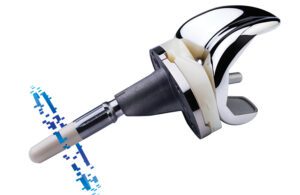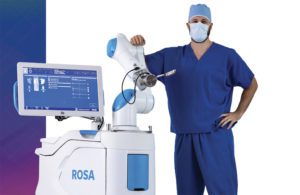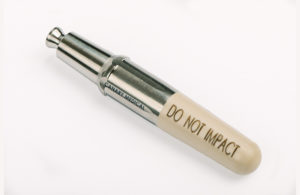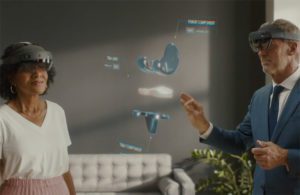
Zimmer Biomet’s Persona IQ smart knee implant has sensors to measure device performance and patient recovery. [Image courtesy of Zimmer Biomet]
Zimmer Biomet’s robotics, technology and data president offers data integration advice, identifies opportunities beyond orthopedics and discusses tech she’s looking for.
Zimmer Biomet is collecting more data than it knows what to do with — and that’s a great opportunity, says Liane Teplitsky.
Teplitsky is the orthopedics developer’s president of global robotics and technology and data solutions. Her domain has expanded rapidly since she joined Zimmer Biomet from Abbott’s cardiac arrhythmia business in 2020.
Back then, Zimmer Biomet’s ZBEdge digital and robotic technology suite consisted of the mymobility patient care app and the Rosa surgical robotics system for brain and total knee procedures. Now, ZBEdge also includes OptiVu mixed reality technology, Persona IQ smart implants, AI-powered Omni Suite operating room products and the analytics expertise of a data science team.
In an interview with Medical Design & Outsourcing, Teplitsky offered data integration advice for medical device designers and engineers, highlighted data opportunities beyond orthopedics and discussed the technologies she’s looking for.
“The key to the portfolio isn’t only that we have a whole bunch of products,” she said. “It’s really about the data and the interconnection of data between all of those products. We have a large quantity of data that’s coming in — basically, all the products now that we’re launching either collect data or generate data. … The real magic happens in integrating all that data together.”
Data integration is the future

Zimmer Biomet’s Rosa robot-assisted surgery system [Image courtesy of Zimmer Biomet]
Zimmer Biomet products are collecting more data than ever. The mymobility app collects patient data before and after a joint replacement procedure, the Rosa surgical robotics system collects data during surgeries, and sensors inside Persona IQ smart implants can track a patient’s recovery.
Those smart implants can also sense vibration to measure the implant’s stability and how well it’s integrating into the bone, according to ZB partner Canary Medical.
“We’re moving further upstream in the data that we collect — so earlier on in the patient’s journey — and then further downstream as well with Persona IQ that can collect data up to 10 years post-surgery,” Teplitsky said. “If we can really understand and have all of that information, pull it all together, and now integrate it together — that’s the hard work of our data science team — [that’s] really where I think the future is going to be.”
Collecting more data before and after a patient’s surgery will help device manufacturers develop new and improved devices and procedures for better outcomes, including customized approaches for individual patients.
All this data analysis will also help device developers find more efficient ways to treat patients, not only reducing surgical costs and times, for example, but also identifying when a virtual follow-up might be a better choice for a patient than an office visit.
“If you can catch a patient before a complication happens or if you can improve the throughput that the surgeons and hospitals and surgery centers have, that also can help on this holistic cost of care,” Teplitsky said.
Keys for data integration

Zimmer Biomet President of Global Robotics and Technology & Data Solutions Liane Teplitsky [Photo courtesy of Zimmer Biomet]
“Objective measures of data are critically important to be able to guide data-driven decisions,” Teplitsky said.
But serious consideration of data privacy and security — how you collect patient data, store it and use it — should be the first step in that direction.
“If you’re looking at building out and leveraging data, you need to make sure that you have the methodology behind that data privacy and data security really buttoned up,” she said. “We have a saying at Zimmer Biomet that the patient is always the patient and never the product.”
With so many global rules and regulations around data privacy, device developers must understand the cost of compliance, which “becomes quite a heavy lift if you look at all the different countries and their own data gardens around the world,” Teplitsky said.
And Teplitsky emphasized that ease of use is key for data integration. Clinical data coming your way from patients needs to be in a format that’s usable if you want to generate insights to improve care.
“We’re going to be able to take all of this amazing information from a patient’s full continuum of care and we’re going to generate insights that can be really valuable to patient outcomes, to patient recovery, maybe even to patients and how we treat them — the right patient at the right time with the right intervention,” she said.
Medtech’s biggest data opportunity is in the feedback loop

Canary Medical’s Canary Health Implantable Reporting Processor (CHIRP) goes inside the tibial extension segment of Zimmer Biomet’s knee prostheses. [Image courtesy of Canary Medical]
The best opportunities for medtech to take advantage of data — even beyond orthopedics — is in the feedback loop, offering a better understanding of “a patient’s full continuum of care versus just in an OR setting,” Teplitsky said.
“There’s so much more that we can do in creating that feedback loop,” she said. “Looking at the patients preoperatively, are there additional diagnostics that can be done to help them along their journey? And then postoperatively, can we really help them with their recovery? … Are there things that we can understand from a patient’s pre- and postoperative path that can be fed back in to help define what we’re actually doing in the OR?”
Using an orthopedic implant as an example, there might be ways to optimize positioning of the implant to accelerate a patient’s recovery based on recovery data for certain patient populations.
“Whatever technology you happen to have — advanced instrumentation, 3D-printed implants, super accurate cut positioning with a robot, an arm that makes sure that the saw is held really solidly intraoperatively — It’s the feedback loop that lends itself to what you really should be doing intraoperatively for that best outcome and leverage whatever technology is available to ensure that,” Teplitsky said.
Offering another ortho example, she said data collection and analysis might help identify a patient on their way toward a total knee replacement in time to do a partial knee instead, an earlier intervention that might lead to a better outcome.
“There are parallels in other areas of medtech as well where if we could better understand the trajectory of our patients in that feedback loop, we can start really being more upfront about that really idealized, personalized medicine that could give our patients the best possible outcomes,” Teplitsky said.
Technologies on Teplitsky’s radar: Smarter, faster and better
Asked what technologies she’s looking for to give ZBEdge new or improved capabilities, Teplitsky said she’s looking for tech that can help in one of three ways.
“For ZBEdge in general, the goal is smarter, faster, better,” she said. “Smarter meaning objective measures of data across the continuum of care for those insights. Faster is efficiency, and better is better value and improved cost of care.”
That could mean taking consumer-grade technology that patients, surgeons and care practitioners already use and adopting it to make Zimmer Biomet’s products easier to use.

Zimmer Biomet’s OptiVu mixed reality lets surgeons and patients visualize a procedure together using Microsoft HoloLens 2 headsets. [Image courtesy of Zimmer Biomet]
“Mixed reality is a great example of something that if it can accelerate more quickly — the technology itself — we’re going to be in great shape,” she said. “We already have products on the market in a partnership where you can actually visualize what has come across in a CT scan of the hip, look through the OptiVu mixed reality glasses and almost like a video game be helped to position the tools that you’re using intraoperatively.”
As those visualization tools get more accurate and equipment in operating rooms collect and share more data, that will improve the quality and utility of information during a procedure, she said.
Smart sensors — like those that Canary Medical develops for Zimmer Biomet — also have huge potential for increased data collection.
“The sensor technology that we have within our Persona IQ and the information that’s coming across on it today, some of that information — because it’s brand new — we’re not totally sure how to use it,” Teplitsky said. “The insights that we’ll get as we get more and more patients across all of these different platforms and being able to interconnect those together, that’s going to build up the data analytics.”
Related: Tips to help device developers get paid from smart ortho implant maker Canary Medical